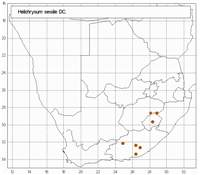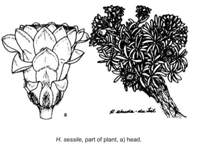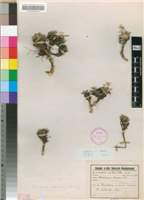Origin of name:
sessile = stalkless or apparently so, sitting close upon the body that supports it
Diagnostic characters:
Mat-formingFew heads in inflorescenceWhite bracts
Description:
A well-branched, very compact cushion-forming dwarf shrublet, 40�100 mm high, old main stems woody, gnarled, up to 15 mm diam., branches densely tufted, clothed below in dead dry leaves, upper leaves closely imbricate, appearing rosetted from above. Leaves c. 5�40 x 1�4 mm, narrowly elliptic or oblong, apex subacute to obtuse, both surfaces enveloped in thick white indumentum, surface silky-smooth, drying like crumpled tissue paper, breaking down with age to felt. Heads homogamous, campanulate, c. 5�7 x 8�12 mm across the radiating involucral bracts, solitary or 2�12 together on short or long (up to 100 mm) leafy peduncles terminating the branchlets. Involucral bracts in c. 4�6 series, loosely imbricate, base woolly, lamina silvery translucent, sometimes crimson above the stereome, tips opaque milk-white, deltoid, acute, radiating, Receptacle scarcely honeycombed. Flowers c. 20�38, yellow. Achenes 1.5 mm long, with elongated highly myxogenic duplex hairs. Pappus bristles many, about equaling corolla, scabrid, apical cells thickened, bases cohering by patent cilia.
Flowering in December and January.
Distribution:
The small cushions grow from cracks and pockets in weathered rock faces. Recorded from the mountains about Graaff-Reinet (Camdeboo Mountains, Koudeveldberge, Cave Mountain, Oudeberg, Sneeuwberg, Tandjesberg). Boschberg at Somerset East, Bruintjeshoogte Mountain near Somerset East, the Great Winterberg and the Amatola Mountains (Hogsback) between 1 370 and 2 300 m above sea level, then a great gap to the mountains near Witzieshoek in the Free State where Thode, Bolus and Flanagan all collected it on the farm Bester's Vallei (Qwa Qwa Mountain) at c. 1 830 m.
Grassland Biome.
Notes:
Heads may be small and crowded (described as H. ernestianum) or larger and then solitary or few together, on short or long peduncles, peduncle length being a response to environmental conditions. But the tufts of narrow leaves with their thick white silky covering are unmistakable, and serve to distinguish H. sessile from H. sessilioides, which has the upper leaf surfaces clothed in thin 'tissue-paper' indumentum, the lower white-felted.
Taxonomy:
Literature:
Helichrysum sessile DC., Prodr. 6: 173 (1838); Harv. in F.C. 3: 219 (1865); Moeser in Bot. Jb. 44: 322 (1910); Hilliard, Compositae in Natal 217 (1977).
Type:
Cape, Sneeuwbergen, Dr�ge 5738 (G-DC, holo.; P, iso.).
Synonym(s):
Gnaphalium evaciforme Sch. Bip. in Bot. Ztg 3: 169 (1845). Type as for H. sessile.
Helichrysum ernestianum DC., Prodr. 6: 173 (1838). Gnaphalium ernestianum (DC.) Sch. Bip. in Bot. Ztg 3: 169 (1845). Type: Eastern Cape, Camdebooberg, alt. 2000�3000 ped., Drege 863 (G-DC, holo.).
H. laevigatum Mark�tter in Annale Univ. Stellenbosch 8, sect. A, no. 1: 46 (1930). Type: Free State, Witzieshoek, c. 1 830 m, Thode s.n. (STE 2794, holo.).
Vouchers:
Bolus 1851 (BOL; K); Esterhuysen 19704 (BOL); Marie Galpin in herbarium Galpin 2652 (K; PRE); Hilliard & Bum 11980 (E; K; NU; S); Nordenstam 1961 (S).

